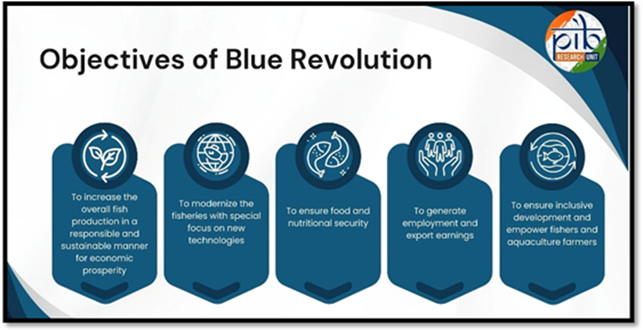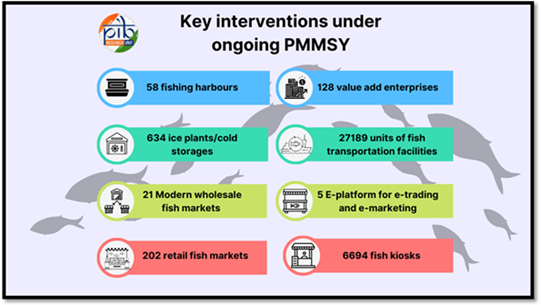Content:
- Casting Nets, Catching Success
- India and Sri Lanka Strengthen Ties in Critical Minerals, Exploration, and Mining
Casting Nets, Catching Success
Introduction
- India ranks as the second-largest fish producer globally, contributing 8% to world fish production.
- The fisheries sector has grown significantly from 2004 to 2024, marked by technological advancements and policy reforms.
- The Union Budget 2025-26 allocated ₹2,703.67 crores, the highest ever, underscoring the sector’s importance.
Highlights of the Union Budget 2025-26
- Financial inclusion: Focus on reducing farmers‘ financial burden and increasing credit access.
- Marine Fisheries Development: Sustainable exploration of Exclusive Economic Zone (EEZ) & High Seas in Lakshadweep and Andaman & Nicobar Islands.
- Kisan Credit Card (KCC) Limit Raised: From ₹3 lakh to ₹5 lakh, boosting financial accessibility for fishers, processors, and other stakeholders.
Growth in Fisheries Over Two Decades
- Increase in Fish Production:
- 2023-24: 184.02 lakh tons
- 2013-14: 95.79 lakh tons
- 2003-04: 63.99 lakh tons
- Increase (2014-24): 88.23 lakh tons vs. 31.80 lakh tons (2004-14)
- Inland and Aquaculture Production Growth:
- 2014-24: 77.71 lakh tons increase vs. 26.78 lakh tons (2004-14)
- Marine Fish Production:
- Doubled from 5.02 lakh tons (2014-24) to 10.52 lakh tons (2004-14).

- Seafood Exports (MPEDA Data, 2023-24):
- 17.81 lakh MT exported, worth ₹60,523.89 crores, a significant jump from ₹609.95 crores in 2003-04.
Policy Initiatives and Schemes
1. Blue Revolution (2015-16)
- First step towards enhancing fisheries productivity.
- Budget: ₹3,000 crores (5 years) for modernizing aquaculture.
2. Pradhan Mantri Matsya Sampada Yojana (PMMSY) (2020-25)
- Investment of ₹20,050 crores for fisheries development, targeting:
- Inland fisheries & aquaculture
- Socio-economic welfare of fishers
3. Key Initiatives Under PMMSY
- Fish Farmers Producer Organisations (FFPOs)
- 2195 FFPOs approved at ₹544.85 crores to empower fishers.
- KCC extended to fisheries (4.5 lakh KCC cards sanctioned).
- Fisheries and Aquaculture Infrastructure Development Fund (FIDF)
- ₹7,522.48 crores fund, supporting 136 projects across states/UTs.
- Pradhan Mantri Matsya Kisan Samridhi Sah-Yojana (PMMKSSY) (2024-27)
- ₹6,000 crores outlay for financial and technological reforms.
- Integrated Aqua Parks
- 11 aqua parks sanctioned at ₹682.6 crores to develop aquaculture.
- Artificial Reefs Deployment
- 937 artificial reefs installed at ₹291.37 crores across coastal states.
- Nucleus Breeding Centres (NBCs)
- Focus on genetic improvement of shrimp & aquaculture species.

Technological Advancements
- Satellite Technology for Fisheries
- Vessel Communication System, Oceansat & PFZ mapping for fishing zones.
- GIS-Based Resource Mapping
- Helps in tracking marine fish landing centers & fishing grounds.
- ICAR-Central Institute of Fisheries Education (CIFE)
- A leading institute training 4,000+ fisheries professionals.
Sustainable Fishing Policies & Regulations

1. National Policy on Marine Fisheries (NPMF, 2017)
- Emphasizes sustainability & conservation of marine resources.
2. Conservation Measures
- Uniform Fishing Ban (61 days in monsoon for fish stock replenishment).
- Bans on Destructive Fishing (pair trawling, bull trawling, LED light use).
- Sustainable Practices: Sea ranching, artificial reefs, mariculture (seaweed cultivation, etc.).
- State-Level Regulations: Gear-mesh size rules, zonation of fishing areas, legal size restrictions.
Conclusion
- India’s fisheries sector has experienced transformative growth (2004-2024).
- Government initiatives, policy reforms, and technological advancements have made India a global leader in aquaculture and seafood exports.
- Sustainability & innovation will be key to maintaining this upward trajectory.
India and Sri Lanka Strengthen Ties in Critical Minerals, Exploration, and Mining
Context & Significance
- India and Sri Lanka are strengthening bilateral ties in critical minerals, exploration, and mining.
- Critical minerals like lithium, graphite, cobalt, and nickel are vital for renewable energy, electric vehicles (EVs), and high-tech industries.
- Sri Lanka has rich deposits of graphite and beach sand minerals, crucial for battery technology and clean energy transition.
Discussions & Agreements
- Mining & Exploration Opportunities:
- India seeks investment opportunities for Indian companies in Sri Lanka’s mineral sector.
- Geological Survey of India (GSI) has shown interest in mineral assessments in Sri Lanka.
- Government-to-Government (G2G) cooperation was discussed for smoother exploration and mining ventures.
- National Critical Mineral Mission:
- India is aiming to secure a steady supply of essential raw materials for energy security.
- Focus on international partnerships and overseas mineral asset acquisition.
- Encouraging Indian companies to expand operations in mineral-rich countries.
- Memorandum of Understanding (MoU):
- MoU on Cooperation in Geology and Mineral Resources is in progress.
- It aims at capacity building, knowledge sharing, and technological collaboration.
- India to support Sri Lanka in modernizing its mining sector through financial & technological aid.
Economic & Strategic Implications
- For India:
- Ensures supply chain security for critical minerals essential for EVs and renewable energy.
- Reduces dependency on China and other mineral-exporting nations.
- Strengthens India’s role in regional economic cooperation & strategic mineral diplomacy.
- For Sri Lanka:
- Attracts Indian investment in mining and processing.
- Enhances mining sector efficiency through advanced technologies.
- Economic boost through resource monetization & industrial growth.
Geopolitical Relevance
- Strategic Cooperation: Strengthening economic ties aligns with India’s “Neighborhood First” policy.
- Countering Chinese Influence: Reducing Sri Lanka’s reliance on China’s mineral investments.
- Supply Chain Resilience: Diversifying sources of critical minerals to avoid monopolization risks.
Way Forward
- Fast-track MoU finalization for structured collaboration.
- Encourage Indian firms to participate in Sri Lanka’s mineral sector.
- Leverage advanced mining technologies for efficient resource extraction.
- Expand cooperation in rare earth minerals essential for future technologies.




